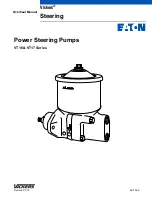
4
Section II - Description
A. General
The VT16 and VT17 series pumps are identical in basic op-
eration and performance characteristics. Differences in the
individual units are covered by variables in the model num-
bers illustrated in Table 2. Service inquiries and parts orders
should always include the complete model number, which
can be found on the pump nameplate.
B. Assembly and Construction
1. The assembly and construction of the VT16 series
pumps are illustrated in cutaway in Figure 1. The unit con-
sists principally of a body, cover, ring, rotor, vanes, pressure
plate, relief valve sub-assembly, driveshaft and reservoir.
The vanes are contained in the rotor slots and follow the
cam shaped contour of the ring as the rotor is driven in rota-
tion by the driveshaft. Fluid flow is developed by the vanes
carrying fluid around the ring contour.
2. The VT17 series is identical to the VT16, except that
in place of the reservoir, the VT17 is equipped with a man-
ifold. The manifold contains a loop circuit passage for oil
from the pressure side of the pump to the inlet. It also pro-
vides oil line connections to the reservoir located elsewhere
in the circuit.
C. Flow and Control and Relief Valve
The integral flow control and relief valve limits the fluid flow
to the system to a prescribed rate. Volume greater than the
rated flow is by-passed to the pump inlet. The relief valve
limits the maximum pressure in the circuit.
Flow
Control
Valve
Figure 1.
Pressure
Plate
Ring
Vane
Rotor
Shaft
Body
Cover
Reservoir
D. Application
Pump ratings, methods of installation and application in-
formation should be obtained from Vickers.
Section III - Principles of Operation
A. General
These units depend on the vehicle engine as a source of
rotary mechanical power to produce fluid flow. Inlet flow is
created by a decreased pressure set up by the action of the
pumping cartridge. Flow is directed through the cartridge to
the pressure port and monitored by the flow control and relief
valve.
B. Pumping Cartridge
The pump cartridge consists principally of a ring, rotor and
vanes (see Figure 2). The rotor is driven within the ring by a
drive shaft, coupled to the power source. Radial movement
of the vanes, and the rotation of the rotor, cause the cham-
ber area between vanes to increase in size at the inlet (large
diameter) section of the ring. This results in a low pressure,
or vacuum in the chamber. This pressure differential forces
oil to flow into the inlet chamber by atmospheric pressure.
Oil is then trapped between the rotating vanes and is forced,
through porting in the pressure plate, to the outlet and into
the system as the chamber size decreases at the pressure
quadrants (small diameter) section of the ring. System pres-
sure fed under the vanes assures sealing contact of the
vanes against the ring during normal operation.
C. Hydraulic Balance
The ring is shaped so that two pumping chambers are
formed 180
°
apart. Thus, any hydraulic loads on the bear-
ings are cancelled.











